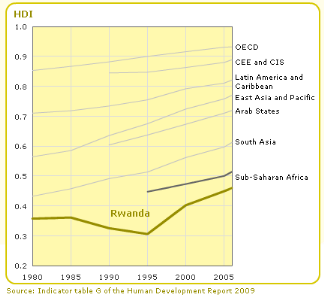4.7.7. Infrastructure for
Development
As term, infrastructures are captured in SUT/I-O Tables by the
Gross fixed capital formation, and in this case is being analyzed as a path to
development of Rwanda.
Infrastructures had increased in Rwanda GFCF value 13% in 1999
to reach 22% in 2009 proportion of GDP, and this increase has affected Rwandans
in many ways: mode of production and consumption, mode of heating and lighting
homes, mode of travelling to work, to schools, or to visit friends and
families, and mode of communicating, sharing information. And the profitability
and competitiveness of businesses are depending on the cost and availability of
infrastructure services (Republic of Rwanda, NISR, GDP Annual Estimates for
2009 based on 2006 benchmark).
In Rwanda since 2000 with the implementation of IMIDUGUDU
policy, physical isolation has been removed out. Before 1999 the government of
Rwanda saw that physical isolation was a strong contribution to poverty.
Populations without reliable access to social and economic
services were poorer that those with reliable access. Problems of access were
particularly severe in rural areas far from roads used regularly for motorized
transport services and hospitals.
In the way of removing out this physical isolation, Rwanda's
Gross Capital formation has been increased as stated above, therefore the
figures in SUT have also been increased, and this indicates in some part the
growth of GDP by production approach and expenditure approach.

In Rwanda, increasing agricultural productivity is central to
rural development and poverty reduction strategies. Because Rwanda has invested
in improving infrastructures, improved rural transport in Rwanda makes rural
development and poverty reduction easier for farmers to obtain input and advice
at reasonable cost and to sell their products at good prices (Republic of
Rwanda, EDPRS, 2007).
With the policy of IMIDUGUDU, AGASOZI INDATWA, rural access
index has been improved regarding investment done. Almost all basic needs for
development have been made available, such as schools, health centres, roads
electricity.
These changes towards development as explained above are
increasing as public and private sector decide to increase investments, and
those investment are captured by the SUT as GFCF which include public and
private sectors. Therefore, the increase in GDP due to the increase in GFCF can
push Rwanda towards economic development.
Also the development of infrastructure basing on AGASOZI
INDATWA and IMIDUGUDU has a significant positive effects on school attendance
and on health improvement, that is why Rwanda's Human Development index is
improving year after year (Republic of Rwanda, NISR: Statistical Yearbook 2009
Edition) .
|
HUMAN DEVELOPMENT INDEX
|
|
YEAR
|
VALUE
|
|
1980
|
0.357
|
|
1985
|
0.361
|
|
1990
|
0.325
|
|
1995
|
0.306
|
|
2000
|
0.402
|
|
2005
|
0.449
|
|
2006
|
0.455
|
|
2007
|
0.46
|
|
2010
|
0.4765
|

As the private sector of Rwanda is improving the SUT/I-O
Tables also experience improvement, the role played by the private sector is at
almost the investment which increases GFCF and those investments provide
infrastructures oriented to the development of rural or urban areas of Rwanda
in all corns of Rwanda.
| 


